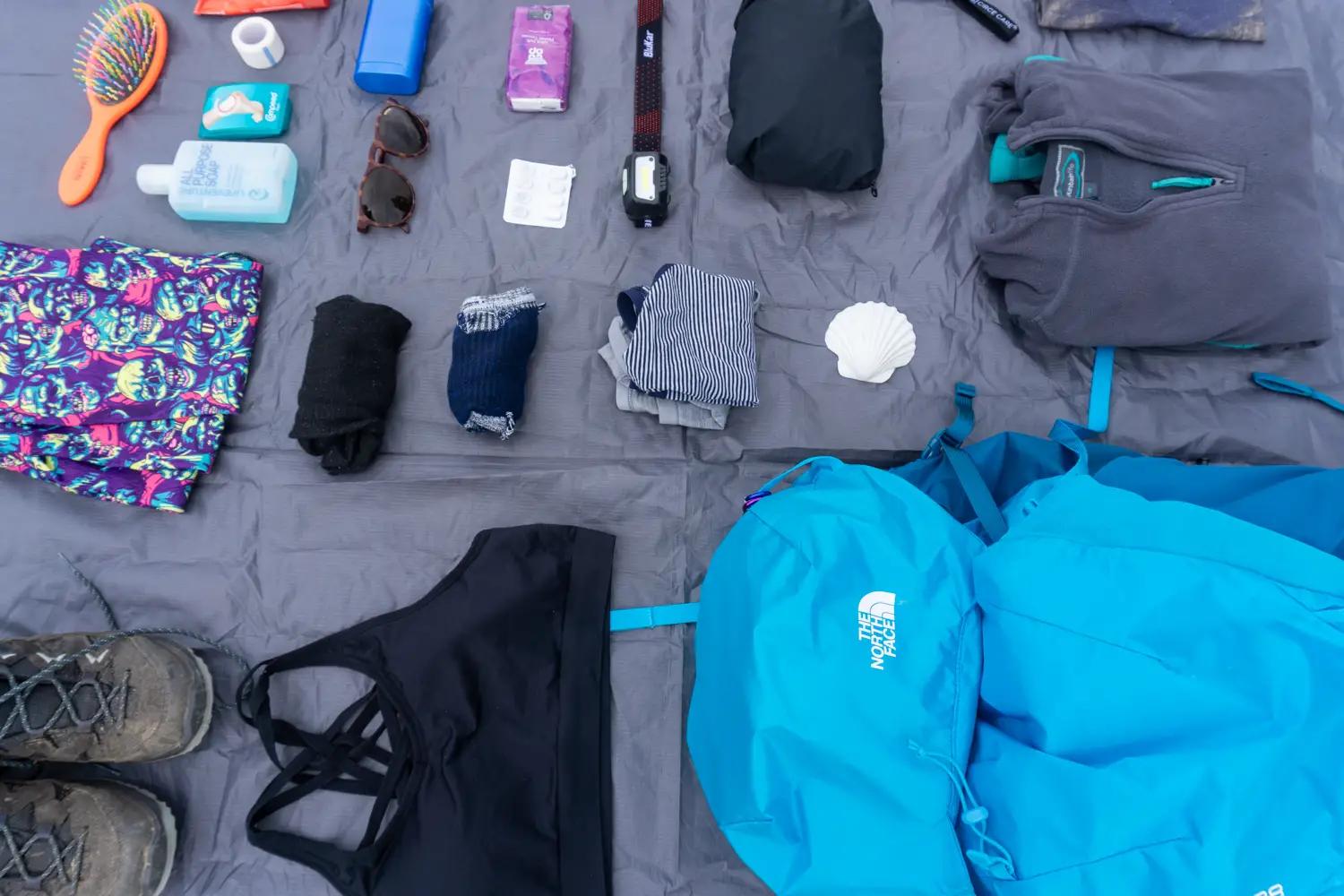Packing for the Camino de Santiago can be a struggle. After all, how many of us have tackled a real thru-hike before? My guess is not many! After completing the French Way between St Jean Pied de Port and Santiago Compostela, I learnt a few things about putting together a Camino de Santiago packing list.
My first and most important piece of advice is to pack light. The rest we can deal with later. This Camino de Santiago packing list has been designed specifically for women, who traditionally have different packing needs than men. It will help you remember everything that you need for your pilgrimage while helping you avoid lugging around unnecessary weight in your backpack. Essentially, I made the mistakes so you don’t have to!
Read more: (opens in new tab)
- Top Tips for Walking the Camino de Santiago
- Fun Things to do in Santiago Compostela
- Choosing a Camino de Santiago Route
Essential Female Packing List for the Camino de Santiago
What Backpack Should I Choose for the Camino?
Choosing a backpack for the Camino de Santiago is one of the most important choices that you will have to make. Your backpack will be a faithful companion over the hundreds of miles ahead and you must make sure that it serves your needs.
Unless you are camping along the trail, you shouldn’t need anything larger than a 40-litre backpack. Bags of this size are generally more comfortable to carry and will easily fit all of the essentials on this Camino packing list.
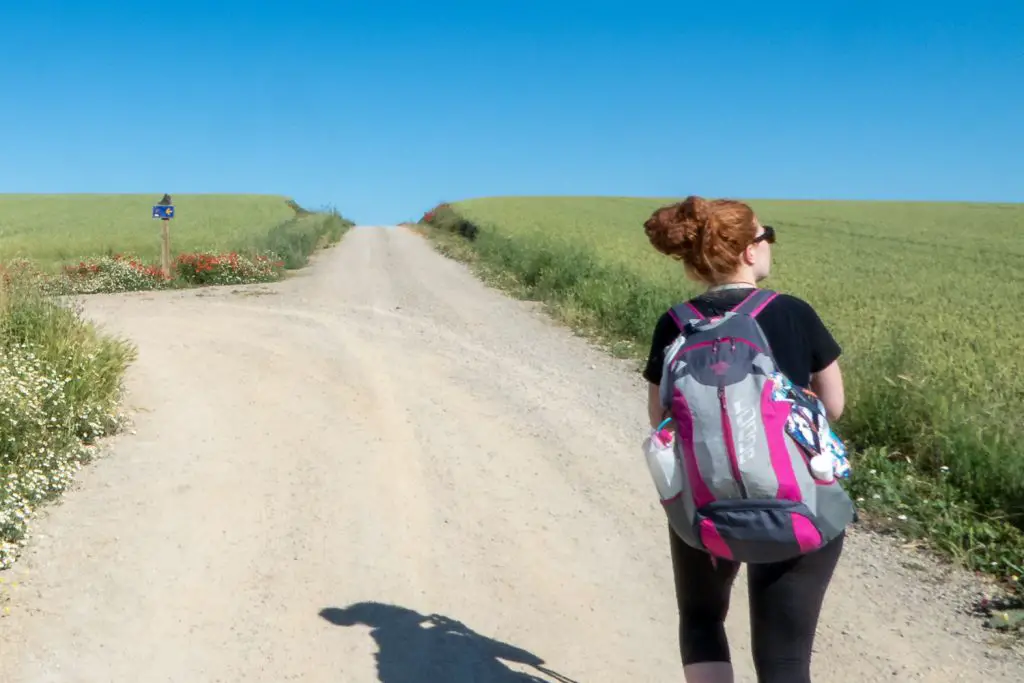
It is always wise to opt for a backpack manufactured by one of the trusted brands such as North Face, Osprey, Deuter, Gregory or Cotopaxi. When I walked the Camino de Santiago, I used an old, cheap backpack which broke halfway through the journey and caused me no end of discomfort. All of the listed manufacturers offer a good warranty which goes to prove how much they believe in the quality of their products.
Since my Camino de Santiago journey, I have upgraded my backpack and now hike with a North Face Hydra 38-litre bag. Other backpacks which come highly recommended for hiking include the Osprey Kyte, Osprey Eja and Gregory Jade.
When buying a backpack for the Camino de Santiago, you should consider the following essential features.
- Is it female-specific? Several brands now cater specifically to women’s shapes. These bags tend to have narrower shoulder straps and wider hip belts to better support the female frame.
- Does it come with a rain cover? Although the Camino is famed for winding through the landscapes of France, Spain and Portugal, you’ll still need a rain cover in case of a downpour. Not all backpacks include one so if yours doesn’t, you’ll have to be prepared to splash out and buy one separately.
- Is it a framed backpack? A framed backpack will help to spread the weight of your bag across your whole body, making it more comfortable to carry over long distances.
- Does it have a hip belt? A durable hip belt helps to remove weight from the shoulders and better distributes the weight of the backpack and its contents. If you can find one, opt for a backpack with hip belt pockets. This makes smaller items like your phone and cash easily accessible while you’re on the move!
Camino Packing Tip! Your backpack should weigh no more than 10% of your body weight when full. Overpacking can increase the chance of injury on the trail and make for a miserable Camino experience.
Clothing for the Camino de Santiago
- 3 x pairs of merino wool underwear
- 3 x pairs of merino wool socks
- 1 x pair of comfy socks for relaxing
- 1 x pair of quick-dry shorts
- 2 x sweat-wicking leggings
- 1 x lightweight pants
- 2 x sports bra
- 1 x vest top
- 2 x quick dry t-shirts
- 1 x hiking fleece
- 1 x hat
- 1 x packable rain jacket
- 1 x rain poncho
- 1 x sunglasses
The most important thing to consider when packing clothes for your Camino is to opt for lightweight items which can easily be layered up. Everything that you intend to wear while hiking should be sweat-wicking. This will not only be more comfortable but also better staves off the chance of getting any nasty yeast infections because of heat build-up.
I am a big fan of wearing leggings to hike in but if they are not your thing, you can always substitute them with a pair of zip-off rain pants. Be aware that if you are a woman with curves, it can be difficult to get a pair of these which properly fit your body shape.
For underwear and socks, it really is worth spending the extra money on merino wool products. Merino wool has natural antibacterial properties which means it doesn’t hold bad smells. It also regulates temperature, making it a breathable choice for all weather. A lot of hikers recommend Darn Tough socks which come with a lifetime guarantee.
You should have one change of clothes that you wear solely for relaxing. Don’t worry about looking good, instead opt for something comfy and lightweight that you’ll feel comfortably chilling out in. To save weight, I wore these clothes while sleeping too.
When it comes to rainwear, opt for a packable jacket as it is easily accessible and lightweight. Your rain poncho should not only cover yourself but also your backpack. Even if you have a backpack cover, a poncho offers another degree of defence in bad weather. There is nothing worse than struggling through a wet, miserable day to find your spare pair of clothes soaking inside your backpack!
Footwear for the Camino de Santiago
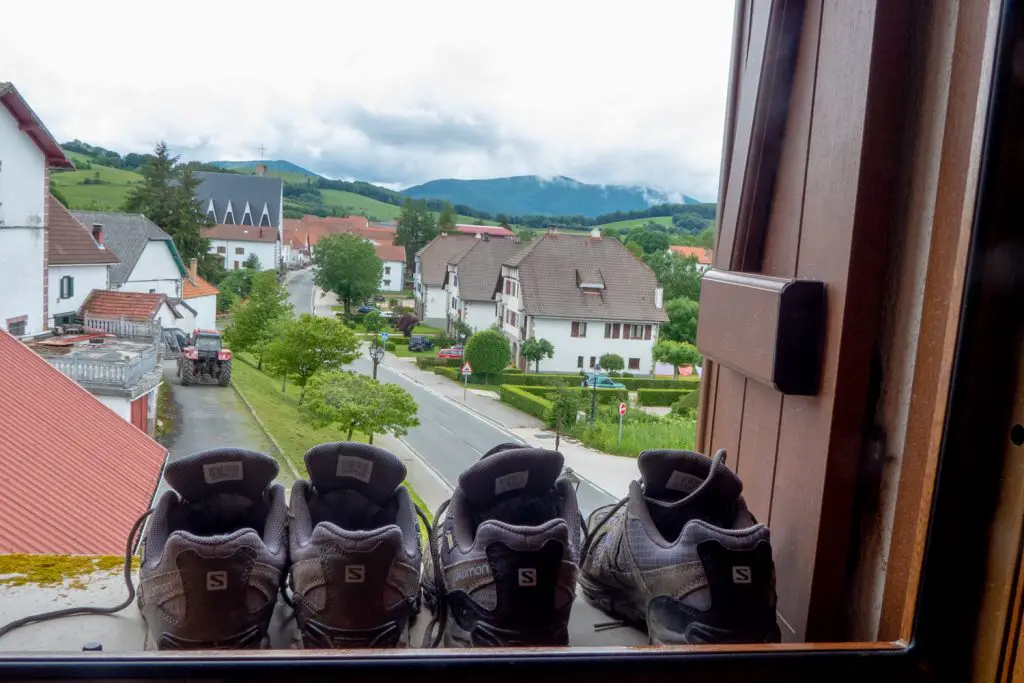
- 1 x hiking boots/trail runners
- 1 x hiking sandals
- 1 x flip flops
Whether you opt for a pair of hiking boots or trail runners is really a matter of personal preference. Personally, I prefer hiking boots because I appreciate the level of additional ankle support offered. I’d recommend buying your boots a little larger to allow your feet room to swell and move about on the ascents and descents. Despite them being a little roomy, you shouldn’t feel your toes hitting the end of the toe box!
While it may feel like a great idea to take your new pair of boots on their first outing on day one of your Camino, this is definitely not advisable. Break in your new boots before embarking on your Camino journey. This will save you a lot of blisters (and heartache)!
A lightweight, comfortable pair of walking sandals are recommended for chilling in hostels and albergues. Bear in mind that if your blisters get too bad in your hiking shoes, you may end up needing to walk in your backup shoes. As such, I’d recommend a durable sandal that can also be used along the trails.
Many people also recommend a pair of flip-flops for use in communal showers, however, this is a matter of preference. You may want to swap out the sandals for flip-flops depending on pack space.
Electronics
- 1 x e-reader and charging cable
- 1 x mobile phone and charging cable
- 1 x portable charger
- 1 x camera and charging cable
- 1 x multiple USB charger
- 1 x European charging adaptor
- 1 x rechargeable head torch
Many pilgrims on the Camino de Santiago choose to go tech-free. I walked the Camino Frances with my laptop and it would be fair to say that this was frowned upon by some of my fellow pilgrims. However, while a digital detox is right for some, it isn’t right for everybody. Remember to walk your own Camino.
Toiletries
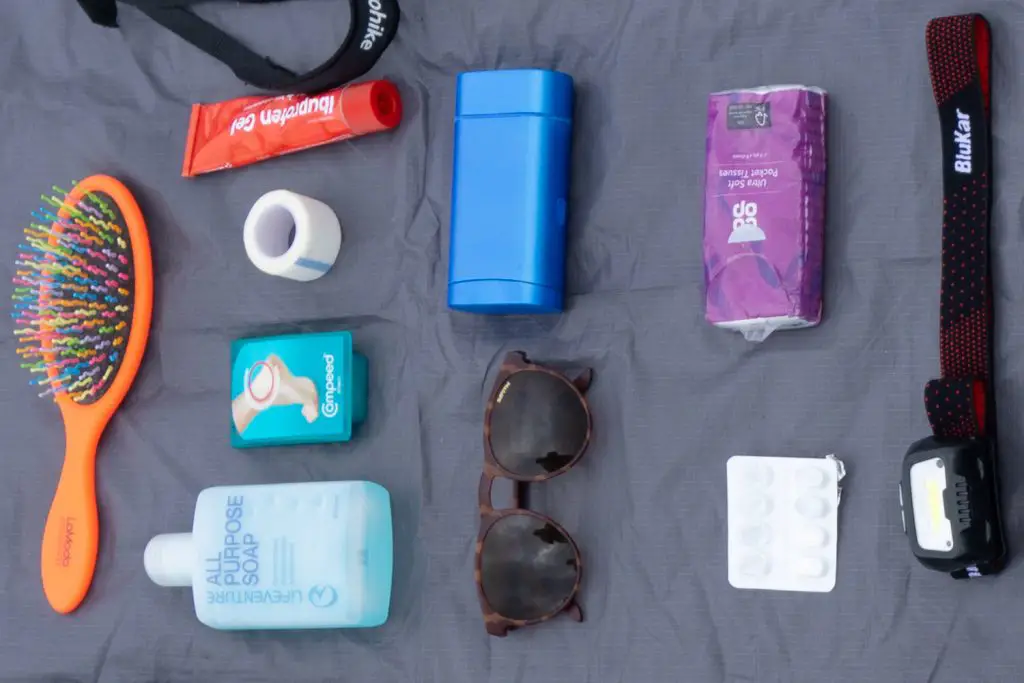
- Hairbrush
- Toothpaste and brush
- Face cloth
- Microfibre towel
- Nail clippers
- Deodorant
- Shampoo/conditioner/soap bar
- Razor
- Pocket tissues
- Suncream
- Lip balm
- Menstrual cup
- Talcum powder
- Kula cloth
When it comes to toiletries, the more sustainable options are often better. For example, solid shampoos and conditioners take up much less backpack space and are lighter than traditional liquid alternatives. The same is true of a menstrual cup over pads or tampons. The planet will thank you for these eco-friendly choices too!
Although there are toilets along the Camino de Santiago route, there will undoubtedly be times when you are caught short in the middle of nowhere. Instead of tearing through rolls of toilet paper, opt for something a bit more sustainable. A reusable Kula cloth (or similar) can be used for wiping and then cleaned when you get the opportunity. Made with silver thread, Kula cloths are anti-microbial. They prevent the build-up of bacteria and odours.
First Aid Kit
- Contraception
- Diarrhoea tablets
- Blister plasters
- Scissors
- Vaseline
- Compression bandages (at least one for each leg)
- Anti-histamine
- Barrier tape
- Paracetamol
- Ibuprofen gel
- Sewing kit
- Rehydration sachets
Camino Packing Tip! Although you will be able to find blister plasters at any pharmacy along the trail, they are expensive! Don’t skimp out on the cheaper unbranded foot care options, stick with Compeed whenever possible and stockpile a few packs for your first few days on the trail.
Washing
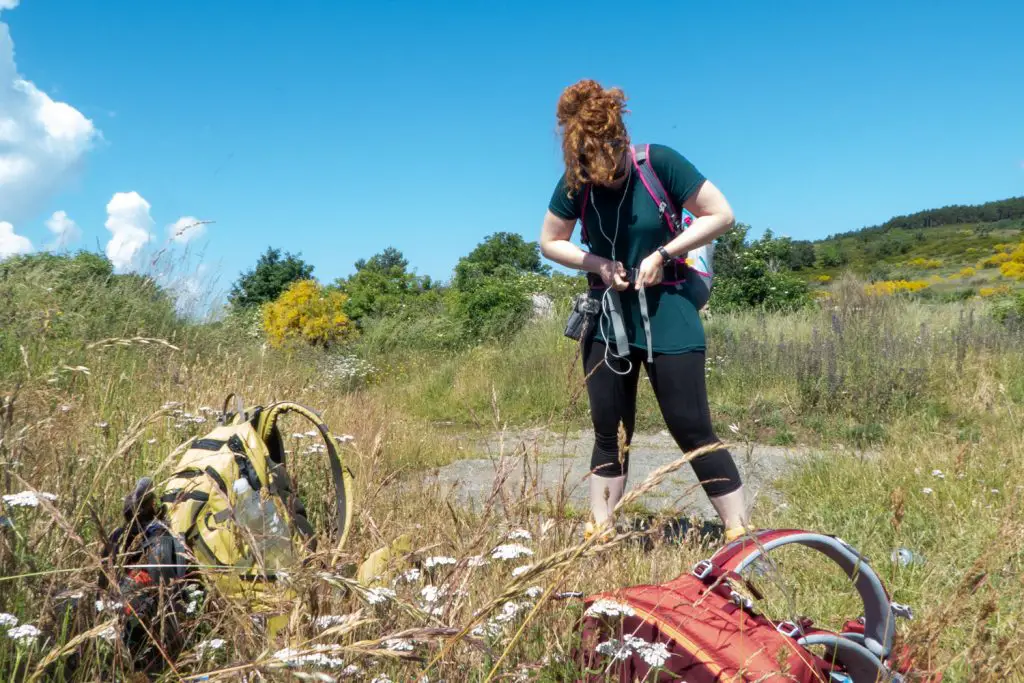
- 1 x Scrubba wash bag
- 1 x bottle of high-strength detergent
- 1 x portable washing line (no pegs)
If you choose to walk the Camino, especially during the summer months, you need to be prepared for your clothes to get very stinky. As such, washing will become a frequent feature of your journey. Although laundrettes are regularly scattered en route, costs quickly mount up if you are paying somebody to do all of your washing for you.
For my Camino, I invested in a Scrubba wash bag which essentially acts as a portable washboard. Throw in your clothes, fill it with water, add in a little bit of detergent and you’re ready to go. While your albergue may have a wash basin for clothes, they don’t always provide detergent so it is best to bring your own.
I’d also recommend packing your own portable washing line. A pegless option is ideal because it means you won’t have to worry about how you’ll hang your stuff. Again, some albergues do provide these but there can be competition for them and it is easier to use your own.
Miscellaneous
- Duct tape
- Passport
- Ear plugs
- Water bottle or hydration bladder
- Sleeping bag liner
- Guidebook (I used the one by John Brierley)
- Ziplock bags
- Credencial (Pilgrim Passport)
- Hiking pole/s
- Scallop shell
Some choose to hike the Camino with poles whereas others don’t feel that they need them. Personally speaking, I wouldn’t hike anywhere without trekking poles. They massively assist with balance over uneven terrain and can take a lot of your body weight, making ascents and descents easier.
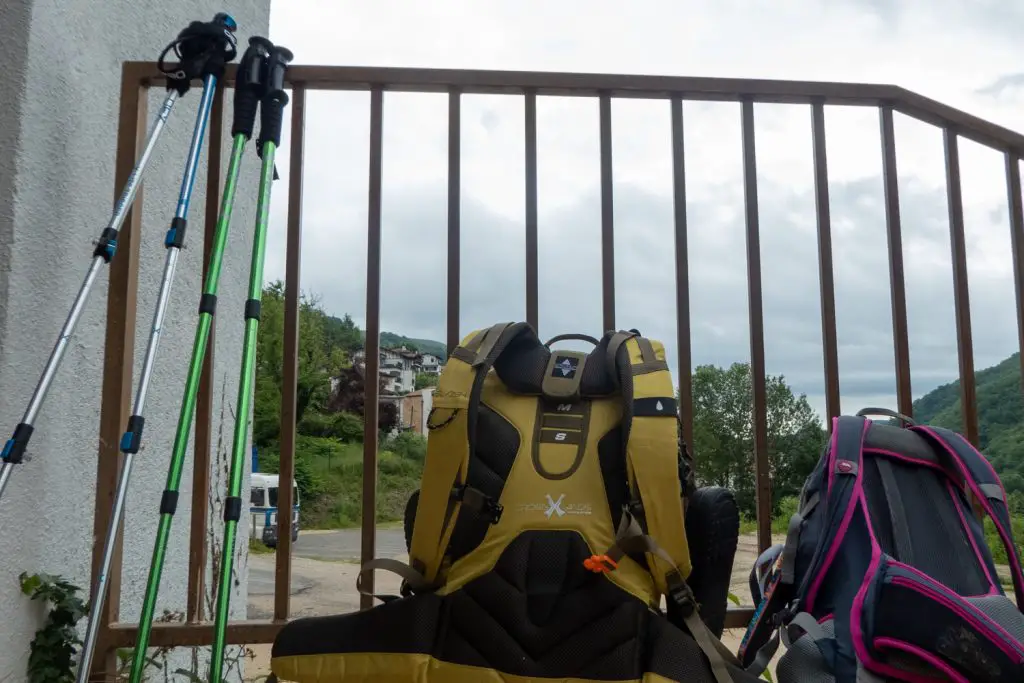
Unless you are planning to camp along the Camino (which isn’t technically allowed), you’ll be staying in hostels and albergues. Most of these will provide disposable sheets inclusive of the bed cost. This is a bed bug prevention measure.
Sleeping bags are heavy and bulky, not to mention probably too hot for most people. A sleeping bag liner should more than suffice.
When it comes to hydration, the amount of water you carry while you hike is really a matter of personal choice. I’d recommend opting for a collapsible water bottle so that you can pack it away when it is not in use. You’ll pass through towns very regularly so you shouldn’t need to carry too much at a time unless you are on one of the more remote Caminos out of season. Other hikers will prefer a hydration bladder but I think I would be encouraged to pee too often!
Pick up your credencial (also known as a Pilgrim Passport) before you officially start your trek. This will help you document your journey and also entitles you to stay in pilgrim hostels and eat pilgrim dinners en route. Essentially, it proves that you are a pilgrim on the Way of St James.
Are you even on the Camino de Santiago if you don’t have a clamshell attached to your backpack? This has long been the symbol of The Way and many pilgrims don a shell to demonstrate to others that they are on the trail.
Read more about the scallop shell symbol on the Camino de Santiago.
And there you have it! All the Camino essentials that you need to reach Santiago de Compostela. It is always worth remembering that this pilgrimage is a very personal journey and you may want to customise this packing list for your individual needs.
The key to successfully packing for the Camino is to try to keep your bag as light as possible and take only what you really need. When you pack, imagine you are a tortoise with your home on your back. That extra pair of shoes doesn’t seem quite so important now!
El Camino is an epic adventure that you will remember forever. Although packing is an important factor, don’t beat yourself up too much if you forget something. No matter whether you’re on the Camino Portugues, the Camino Primitivo or another Camino route, they will have shops where you can stock up on essentials.
The only thing left to say is Buen Camino!
What would you add to my Camino de Santiago packing list?

